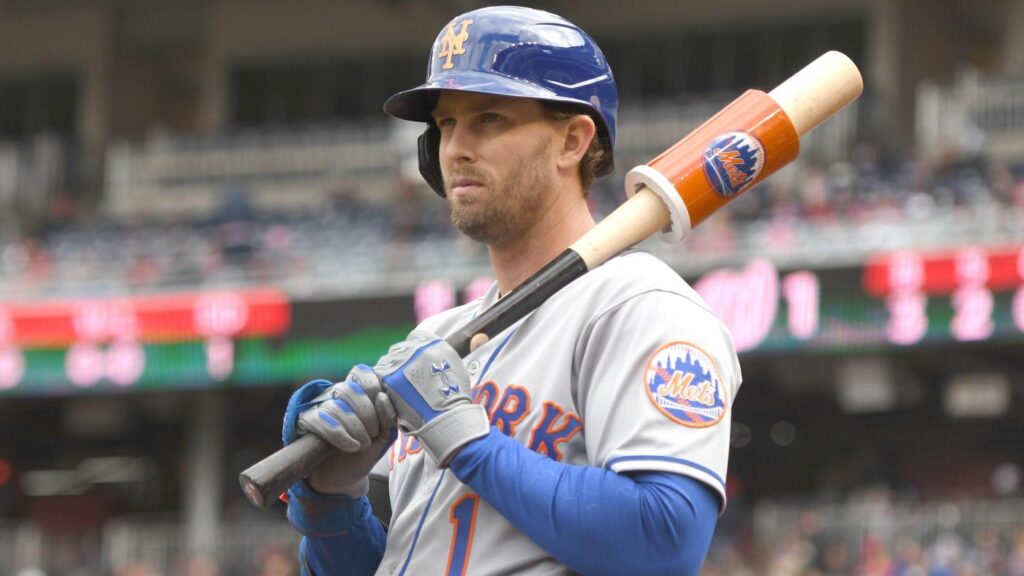
It’s still far, far, too early in the Mets’ season to make any bold declarations or draw any sort of hard conclusions.
Still, the team is 9-3, off to the best start of any team in the league. Surely, there will be pieces of that hot start that deteriorate or cool off as spring turns to summer. But nine wins in 12 games don’t happen accidentally, and while some of the reasons for the Mets’ rising stock are obvious (Francisco Lindor slugging .619, the pitching staff making up for the lack of Jacob deGrom by all doing their best deGrom impression), there are some subtle adjustments that also seem to be taking hold.
By diving into the extremely limited data available thus far, one major thing that stands out is Jeff McNeil’s plate discipline. The Flying Squirrel was in hell last year, when he went from a career .319 hitter to batting just .251 with a glaring lack of extra base hits. The early returns on his 2022 season have been strong — though he’s still making a ton of weak contact to produce mostly singles — and McNeil has shown a much more discerning eye in the batter’s box.
According to FanGraphs, the Mets’ scrappy contact hitter swung at 33.5% of the pitches he saw outside the strike zone last season. Through his first 47 plate appearances entering Wednesday night’s game, that number is all the way down to 24.8%. While the numbers will stabilize as the year goes on, and McNeil is likely to trend back toward his career habits, the patience he’s shown thus far also points to a concerted effort to make the pitchers work.
Even when going 0-for-4 with a strikeout as he did in the second game of Tuesday’s doubleheader, McNeil was a nuisance to Giants’ pitching. He saw an average of 5.75 pitches during his four plate appearances, including two that lasted seven and nine pitches before ending in outs. There’s value to that, especially when the likes of Lindor, Starling Marte or Pete Alonso are hitting behind him. This stacked Mets lineup does not afford the opposition much time to breathe, and if McNeil is constantly fighting pitches off or watching balls sail wide of the plate, he makes things even more difficult for a laboring pitcher that still has several All-Stars waiting for him.
The biggest difference between McNeil’s lackluster 2021 and his so-far-encouraging 2022 has come against breaking pitches. Last season, as the Long Beach State Dirtbag struck out more frequently than he ever had, he chased 30.2% of the wayward breaking pitches that came his way. This year — and again, it’s much too early to definitively say these numbers will hold up — he’s down to 14.3%. Whether this was a point of emphasis for McNeil during the offseason, the work of new hitting coach Eric Chavez, or both, it’s an immediate ray of hope for a team that’s been full of them in the early going.
As long as Mark Canha is on the COVID list, one has to imagine McNeil will be the Mets’ regular left fielder. His current combination of pesky at-bats on offense and athletic catches on defense make him a more than admirable fill-in at an unnatural position.
The Mets have enough depth to mix-and-match based on a given day’s matchup, and the designated hitter helps in that respect too. Coming into the year, McNeil appeared to be locked up with Robinson Cano in the great battle for second base. At this moment, McNeil and his sagacious approach — the keen strike zone monitoring has also led to a 10.6% walk rate — need to be starting every day. Once Canha returns from the virus, McNeil presumably slides back to second base with Cano, J.D. Davis and Dom Smith rotating at designated hitter.
Having more capable players than available lineup spots is the definition of a good problem. For so long, Davis and Smith’s main relationship to Mets fans was trying to figure out who they could fetch in a trade. But so long as they’re still here, McNeil is hitting again, and Cano’s candy-sweet swing keeps putting a charge in the ball, the Mets are one of the deepest teams in the game. The fruits of that depth have been enjoyed on both sides of the ball already with deGrom, Canha and Nimmo each missing time. Paired with Buck Showalter’s stewardship, it’s hard to look up and down this roster and find an obvious hole.
McNeil could very well become undisciplined again as the season wears on. If sportswriters have figured out that a big chunk of his early success has come from laying off enticing curveballs and sliders, MLB coaching staffs are even more aware of it. The name of the game, especially over a 162-game plod, is making adjustments.
The newly-minted 30-year-old has made some of those necessary adjustments already. McNeil has always been a persistent contact hitter, but with this extra dash of restraint he’s been showing in the first weeks of the season, he’s shot himself into the 95th percentile of whiff percentage. As it turns out, great contact hitters become even greater when they’re not swinging at the un-contactable pitches.
With a new Rolex — which came from giving his old No. 6 uniform number to Marte — to go along with the team victories and his own personally exciting statistics, McNeil is experiencing the luxurious lifestyle he and the Mets have long dreamt of.
()
